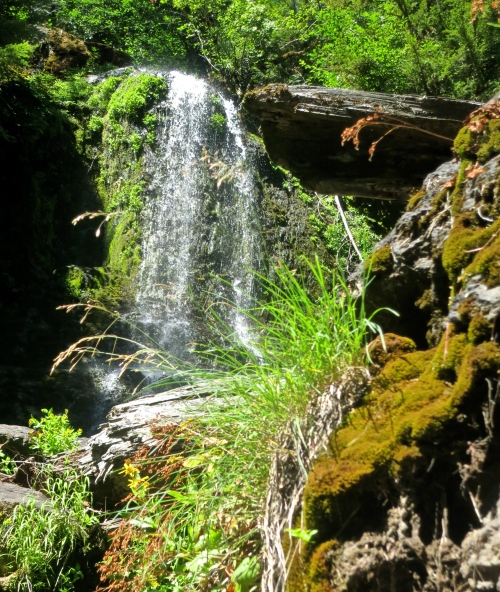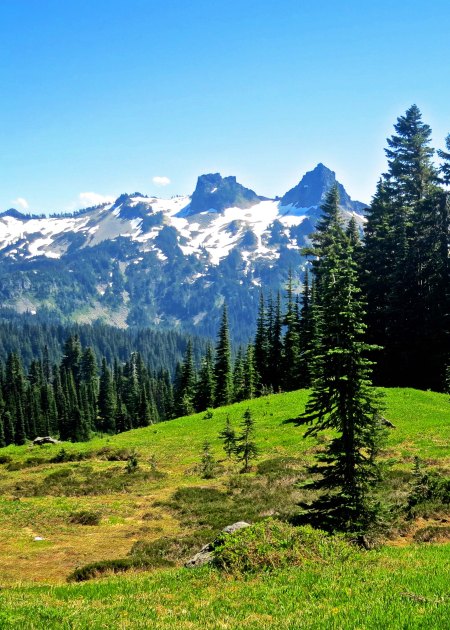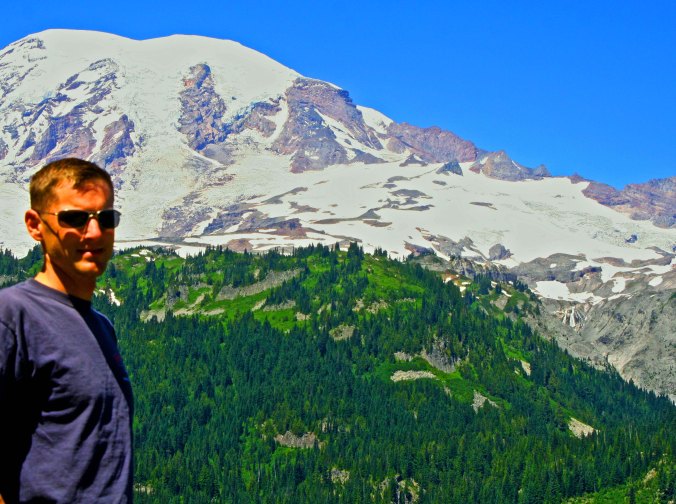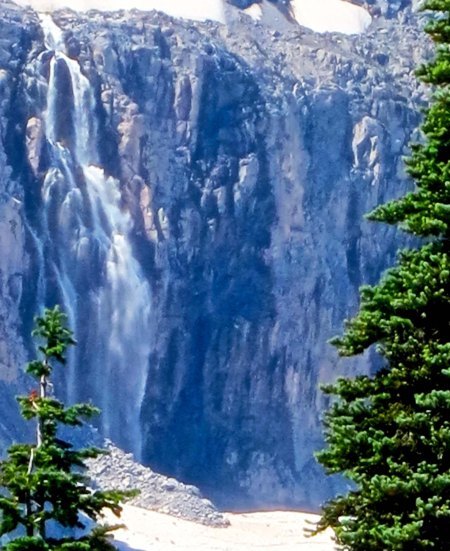
Mt. Rainier National Park has much more that its majestic mountain to offer visitors. Ancient forests, glacial rivers and tumbling waterfalls are found throughout the Park.
At 14, 410 feet (4,392 meters), Mt. Rainier is the tallest volcano in the Cascade Mountains, a range that starts in northern California and works its way through Oregon and Washington before ending in southern British Columbia. The range is part of the famous, or perhaps I should say infamous, Ring of Fire that surrounds the Pacific Ocean and represents the epic crashing of oceanic and continental tectonic plates. Volcanic eruptions, earthquakes and tsunamis are its legacy.

Starting at Mt. Shasta (shown here) and Mt. Lassen in northern California, the Cascade Mountain Range of volcanoes works its way northward into southern British Columbia.
Rainier is an active volcano, which means it is capable of blowing its top at any time. Every volcanic eruption in the last 200 years that has taken place in the contiguous United States (outside of Hawaii and Alaska) has happened in the Cascade Range. The most recent was Mt. St. Helens in southern Washington, which exploded in 1980. I flew over the mountain a few weeks after the eruption. The destruction was unimaginable.

Mt. St. Helens today, its once majestic peak now a crater. The river has carved a canyon through the mudflow the volcano left behind. I took this photo two years ago.
Jet stream driven storms coming off the Pacific Ocean bring the rain that the North West is justifiably famous for. During the winter, this rain turns to snow as the storms are forced up and over Mt. Rainier— lots of snow. During the winter of 1971/72, 1,122 inches of snow fell. This translates into 93.5 feet or 28.5 meters. It set a world record at the time. The snow is responsible for the 14 named glaciers that slowly work their way down from the top, grinding up rocks as they go, and creating several rivers.

Fed by the Emmons, Frying Pan and Winthrop Glaciers, the White River is given its color by ground glacial rock dust. BTW: Ancestors of my mother barely missed being massacred by indians on the White River around the time Seattle was founded.
Peggy and I, along with our son Tony, worked our way clockwise around the mountain from the Sunrise Visitor Center to the Henry (Scoop) Jackson Memorial Visitor Center, covering about a third of the mountain. The road has enough twists and turns to hassle a snake and has more picturesque scenes than a National Geographic photographer could capture in a month. Misty waterfalls and an ancient forest competed with the snow-topped mountain for our attention. We finished off our exploration of Mt. Rainier with a breath-stealing hike that climbed up 1400 feet behind the Jackson Memorial Visitor Center.

You would expect to find large trees in an area called the Grove of Patriarchs. We weren’t expecting this. Peggy is perched inside the roots of a downed patriarch. Or maybe it was a matriarch.

This creek flowing through the Grove of Patriarchs immediately made me think of a Claude Monet Impressionist painting.

Whirls of wood grain appeared on a downed tree in the Grove. I was reminded of a 3-D topographic map.

We came across a saffron robed monk throwing snowballs as we hiked on the trail above the Jackson Memorial Visitor Center. “Throw one at me,” I urged with camera poised.

One of many views we had climbing up the trail. As I recall, Peggy broke out singing Climb Every Mountain. It was a Julie Andrews’ moment.

Peggy captured Tony at our turn around point on the trail. He wanted to keep going to the top of the green hill but was outvoted by Mom and Dad. (Photo by Peggy Mekemson.)

A final goodbye view of Mt. Rainier. Next Blog: We begin our kayak adventure and search for Orca Whales off the north coast of Vancouver Island.





These pictures are brilliant, some of my favorites of yours. The one of Peggy in the tree roots is really unique.
Thanks Carrie! It was quite brave of Peggy. Mosquitoes lurked back inside the tree and they love Peggy. 🙂 –Curt
Beautiful! And so glad to hear your mother’s ancestor avoided a massacre. Washington is a glorious state, and your photos do it justice. Thanks for the hike around Mt Rainier!
Glad to have you along for the hike. And if my mother’s ancestors hadn’t escaped the massacre, I wouldn’t be here doing this blog. 🙂 –Curt
Amazing photos. Let’s hope the vulcano remains peaceful.
Thing about volcanoes Gerard is you never know whether they will erupt in the near future or ten thousand years from now. 🙂 -Curt
FANTASTIC photographs! Like seeing all of my childhood favourites – Mutual of Omaha, Walt Disney and National Geographic – rolled into one…
Unbelievable. Just un believable.
Hope you enjoy Vancouver Island. (Really looking forward to your documentation: )
Thanks so much Deb. That’s quite a compliment. Peggy and I always enjoy sharing our adventures to beautiful and interesting locations… which is just about anywhere. 🙂 –Curt
These photos are absolutely brilliant. Breathtaking. Really enjoyed this.
Many thanks. Having beautiful surroundings always helps in photography. 🙂 –Curt
That view! Certainly inspires a Julie Andrews moment 🙂 I’m singing, climb every mountain . . . Thanks for sharing your wonderful photos. The downed matriarch is something!
Glad you enjoyed them Timi. Mt. Rainier is spectacular. BTW: Peggy has a great singing voice. Glad you picked up on the “Matriarch” comment. I couldn’t resist. 🙂 –Curt
What a fabulous post – the photos quite stunning. Especially like the one of Peggy sitting in the tree root – looks like a painting too.
Thanks AC. I think Peggy in the tree is winning the most popular photo. (grin)
One of the things I like about your posts is the variety of images. The corn lily, wood whorls and white river water are the sorts of things most “here’s Mt. Ranier” articles don’t provide.
Thanks, Linda. It’s whatever catches the eye. Some things I look out for. I know that corn lilies and dead wood are going to present interesting picture possibilities. –Curt
Gorgeous scenery! Magnificent photos. Love the one of Peggy in the tree roots.
Thanks. We had fun with the roots. 🙂 -Curt
I have to agree, Peggy is a good sport for braving the mosquitoes for a blog photo…and the texture on the downed tree is awesome. -Ginette
Yes, Peggy is a trooper. We also put our son Tony in there for a photo. Can’t pass up photo-ops like that. 🙂 –Curt
Curt – if there was anyone other than you who could show us lovelier photos of Mt. Rainier and educate us at the same time, I want to meet that person. Well done.
Thanks Bruce. Kind words much appreciated. –Curt
Oh how your photos are just stunning. So much beauty. I love the bits of story behind them. The monk must have been a surprise too. This is a gorgeous park and I like that you took the time to photography the small details, less spectacular and yet so gorgeous, like the flowers for example. I feel like going. Now.
Now you might run into a heck of a storm, Evelyne. lol The whole Northwest is under a siege. Including here, which is a good thing. Thanks for your comments. Mt. Rainier is a indeed a gorgeous park. –Curt
Stunning photography! I was trucking out there when she blew what a mess back the. Beautiful now.
I had helped plan a bike tour for the ALA of Washington to Mt. St. Helens at the time. Needless to say, it was cancelled. 🙂
I had ash in my rig where none should have been lo I am glad you are also here to talk about it.
I can see what you mean about photographs in all directions. I am totally smitten with the swirly topographic tree trunk, but actually by everything there.
I suspect the swirly tree trunk appeals to your sculptures eye, Hilary. –Curt
Thank you for sharing your magnificent photos to your stories Curt. I had a friend in the service who actually sent me ashes of St. Helen when she erupted and I still have it!~
You are very welcome Slingshot. Glad you enjoyed the mountain. –Curt
How wonderful you, Peggy & your son enjoy these excursions..wonderful memories indeed..
I too love that “Monet” creek.. can you swim there?
The ‘Monet’ creek was a little shallow where we were but I an sure one wouldn’t have to look far to find a swimming hole. Tony actually waded across it. Peg and I took a shaky, swinging, wooden bridge. 🙂 –Curt